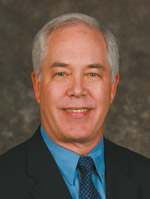June 3, 2011
Laser Refractive Surgery
 By Richard Phinney, M.D.
By Richard Phinney, M.D.
Eye Surgeons Associates
Laser refractive surgery is the term given to a number of procedures designed to change the focusing properties of the eye. The clear curved cornea is modified by the application of laser energy in such a way that images are more accurately focused on the retina reducing or eliminating the need for glasses or contacts.
Photo refractive keratectomy or PRK is the procedure first approved to correct nearsightedness and astigmatism by the FDA in 1996. The excimer laser energy is placed directly on the surface of the cornea to reshape it in such a way that the images of distant objects are more accurately focused on the retina. It works well for people with thin corneas who have low to moderate amounts of myopia and astigmatism. Because PRK is performed on the corneal surface, there is typically more discomfort than with LASIK and may limit activities for a few days to a few weeks, but results are as good as LASIK.
Advances in the microkeratome instrument in the late 1990s made the procedure known as LASIK (laser-assisted intrastromal keratomileusis) commonplace. LASIK surgery employs the same excimer laser used in PRK, but the application to the cornea is below the surface. A thin corneal flap (much like a contact lens on a hinge) is first formed by a microkeratome, or more recently, another type of laser. The microkeratome is a mechanical device which uses a blade to cut the flap, whereas the femtosecond laser (IntraLase or iLASIK) creates the flap by accurate application of energy within the cornea. With its excellent safety profile and visual outcomes, the IntraLase Laser Technology is among the fastest growing refractive surgical techniques.
Both techniques take less than a half minute per eye to perform. This flap is retracted on the hinge prior to application of the laser energy on the cornea’s center. The flap is then laid back in place and adheres by natural means. Distance vision is usually good enough for people to be back to work and drive without glasses within 24 hours. Eye drops are used for a few days after LASIK and for several weeks after PRK.
Middle-aged people who require a bifocal segment in glasses to assist reading will still need reading glasses or may opt for something known as monovision. In this situation, one eye is corrected for distance while the other is made somewhat nearsighted for reading. People are able to see at distance with the fully corrected eye and at near with the other. Many people easily adapt to this condition which admittedly, sounds somewhat bizarre. If this option is elected and later the patient finds that they can’t adapt, it is possible to convert the near eye to a distance eye. Reading glasses can then be used.
Today’s laser technology has provided millions of people worldwide with freedom from glasses and contact lenses. The risk of surgical complications exists with all operations, and imperfect vision may be the consequence of laser refractive surgery. National studies indicate that mild uncorrectable vision loss (two lines on the eye chart) occurs in 1 – 2 percent of patients following conventional laser application. Advances in the programming of laser application with information gathered from the unique imperfections of the eye by a device known as an aberrometer give a more precise and personalized “custom” treatment. These custom applications have improved visual outcomes and reduced the risk of vision loss. Not all lasers are approved for this type of treatment.
The laser vision correction marketplace can be confusing for patients. There are differences in the capabilities of FDA approved lasers, differences in surgeon experience, and differences in post-operative care. Sometimes people get caught up in the hype of advertising and forget this is surgery that demands pre and post-operative attention to details by an easily accessed, experienced eye doctor.
Dr. Richard Phinney is certified by the American Board of Ophthalmology and by the American Board of Eye Surgeons in LASIK surgery. Dr. Phinney received subspecialty credentials in diseases and surgery of the cornea at UCLA’s prestigious Jules Stein Eye Institute. Eye Surgeons Associates located in Bettendorf, Muscatine, Rock Island, Silvis and Geneseo, provides comprehensive eye care for the entire family, for a lifetime. For more information visit us online at www.esaeyecare.com.
Filed Under: Health & Wellness
Tags: Accurate Application, Application Of Laser, Corneal Flap, Corneal Surface, Corneas, Distance Vision, Distant Objects, Excimer Laser, Eye Surgeons, Femtosecond Laser, Intralase, Laser Energy, Laser Refractive Surgery, Lasik Surgery, Moderate Amounts, Refractive Keratectomy, Richard Phinney, S Center, Safety Profile, Visual Outcomes
Trackback URL: https://www.50pluslife.com/2011/06/03/laser-refractive-surgery/trackback/


